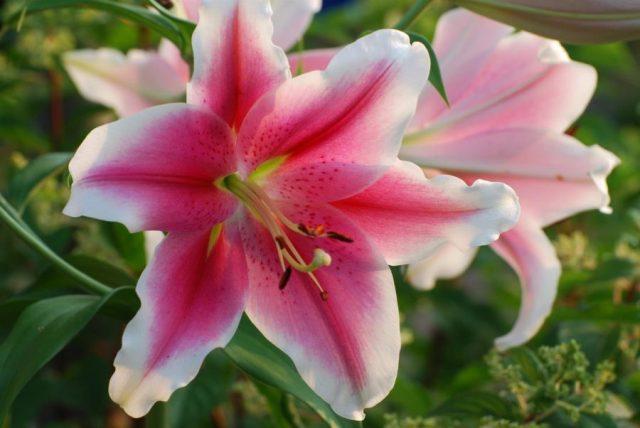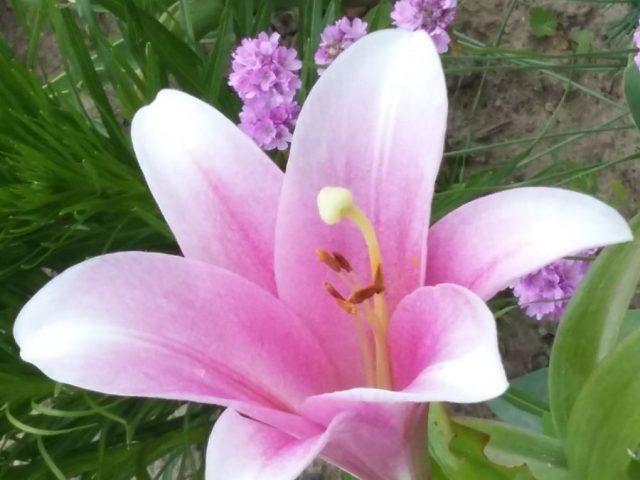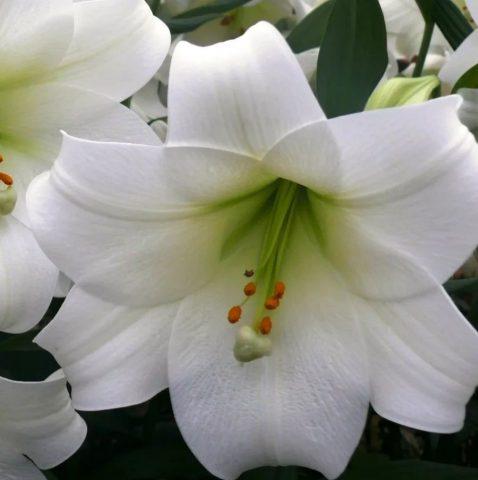Content
LO hybrids of lilies are ornamental plants represented by a large number of varieties. Before planting flowers on the site, you need to study the variety, as well as the features and basic requirements.
Description of LO-lily hybrids
LO hybrids of lilies, as well as LOO hybrids, which are considered an improved variety, are a group of varieties obtained by crossing Asian and long-flowered hybrids. They reach an average of 1.4 m in height and bear large tubular buds up to 25 cm in diameter. The petals have a dense structure and do not fly away from gusts of wind. The buds, depending on the specific variety of LO-hybrid, are white, pink, yellow, red and apricot, as well as combined shades and with specks.

Flowers of LO-lily hybrids have a pleasant soft aroma
When grown, lilies prefer well-lit areas or permeable partial shade; they develop quickly on light neutral or slightly acidic soils. They can remain in one place for up to seven years without losing their decorative appearance.They are easy to force and are often grown as indoor flowers.
Winter hardiness of LO-lily hybrids
Description of LOO hybrids of lilies It is reported that most varieties belong to the category of heat-loving plants. They are suitable for breeding in temperate climates, but require careful shelter for the winter. Hybrids can tolerate frosts below -30 °C only if they have high-quality insulation.
LO hybrids are grown throughout Russia. But for planting in Siberia or the north, it is better to choose varieties with early flowering periods, so that after the lilies wither, they have time to go into a dormant state before the onset of cold weather.
Features of flowering
LO hybrids for the most part bloom quite late - in the second half of July or August. The buds open gradually and emit a pleasant, delicate aroma. There can be up to 3-6 flowers on one shoot. Some varieties form entire cascades of 10-15 buds.
Varieties of LO-lily hybrids with photos
Photos of varieties of LOO hybrids of lilies show that the plants are represented in a huge variety. There are several popular types.
Pink Brilliant
A beautiful LO hybrid blooms with huge, wide-open buds. The center of the petals is bright pink with a crimson spot and longitudinal strokes. A white border runs along the wavy edges.

Pink Diamond flowers reach 25 cm in diameter
Sea Treasure
The LO hybrid grows up to 1.8 m above the ground, each peduncle produces 5-6 large bell-shaped buds. The flowers of this variety are white with crimson spots and a yellow throat.

Variety Sea Treasure blooms in late July and August
Nuance
The winter-hardy LO hybrid grows only up to 1.1 m above the ground surface. Blooms profusely, bearing funnel-shaped buds with elongated triangular petals. In the center the flowers are crimson, then the shade gradually changes and becomes pastel pink and white closer to the edges.

Lily Newans can withstand frosts down to -37 °C under cover
Wendella
The beautiful LO hybrid bears light pink funnel-shaped flowers with dark longitudinal stripes. The outer edge of the petals is slightly forked and has a white border. In the center of the buds there are long bright yellow anthers.

Wendella lily blooms in June and July
White Triumph
The snow-white LO hybrid bears large flowers with satin elongated petals. The buds reach 25 cm in diameter, their necks are greenish.

The White Triumph variety reaches 1 m in height
Planting LO hybrids of lilies
It is customary to plant LO hybrids of lilies on the site in early autumn. After flowering is completed, the bulbs go into a dormant state and react less sensitively to any manipulation.
On the site for lilies, choose a sunny or slightly shaded place. The crop needs nutritious soil, slightly acidic, with good air permeability and without stagnant moisture. The selected location is dug up in advance, the soil is diluted with sand, and humus and peat are added if necessary.
The further algorithm for planting lilies with bulbs looks like this:
- Holes with a depth of 15-20 cm are prepared on the site.
- Place a sand cushion at the bottom of the holes.
- Bulbs of LO hybrids are planted and the voids are sprinkled with substrate.
- Water the flowerbed generously and cover with a layer of sawdust.
Before the onset of winter, the bulbs must be additionally insulated from frost with spruce branches.

When planting LO-lily hybrids, it is useful to add superphosphate to the soil.
Caring for LO-lily hybrids
Immediately after planting lilies, it is necessary to properly insulate the flowerbed and leave it until spring. With the arrival of warm weather, the shelter is removed and the first shoots wait for the appearance. Further care of LO hybrids comes down to several activities:
- Watering. Lilies do not tolerate prolonged drought, but also do not like waterlogging. They need to be watered moderately - so that the soil does not become covered with a hard crust and does not become waterlogged. In the presence of natural precipitation, the intensity of moisture is reduced.
- Feeding. At the beginning of spring, LO hybrids can be fertilized with mullein solution, and at the beginning and at the end of flowering - with minerals containing potassium and phosphorus.
- Loosening. After each watering, the lily bed is weeded and germinating weeds are eliminated.
Immediately after flowering, the remaining shoots of LO hybrids are cut off and watering is completely stopped. When the leaves completely wither, you will need to shorten the stems to 10 cm and add humus to the flowerbed. With the onset of cold weather, lilies are covered with a layer of sawdust, and spruce branches are thrown on top to protect them from wind and frost.
Reproduction methods
LO hybrids can be propagated on a site in several ways:
- Daughter bulbs. After flowering, the lilies are carefully dug out of the ground and the small “babies” are separated from the main tuber. The material is immediately placed in a nutrient substrate. It is impossible to keep daughter bulbs in the air, as this causes them to become flabby and lethargic. The landing of the “babies” is carried out according to the standard algorithm.Already next season, large bulbs can please you with flowers.
- Dividing the nest. The method is very similar to the previous one. The difference is that for propagation they use not “babies”, but full-fledged bulbs, into which the main underground tuber is divided during the growing season. Nests are usually formed by LO hybrids of lilies older than 2-3 years.
- Scales. The method allows propagation to be carried out not in autumn, but in spring. The parent bulb is dug out of the ground and the large upper scales are separated from it, washed with plain water and a weak solution of potassium permanganate, and then treated with a growth stimulator. Planting material is placed in a plastic bag with wet peat, tied and left in a cool room for two weeks. The resulting small bulbs are transplanted into containers with loose substrate, and when the lilies become stronger, they are transferred to open ground.
The latter method of propagation is convenient in that it allows you to immediately obtain from 2 to 15 new plants that retain all varietal characteristics. However, scale lilies will not bloom earlier than in three years.
Diseases and pests
LO hybrids of lilies are highly sensitive and often suffer from fungi and insects. Of particular danger to them are:
- fusarium - the disease affects the bottom of the bulb, develops most often closer to autumn, as a result of which the lily dies during wintering;
Fusarium affects lilies due to excessive moisture
- Wireworm is a soil pest that injures the roots of LO hybrids and disrupts nutritional processes, as a result, an apparently healthy plant begins to wither and completely dies.
Liming the soil helps against wireworms
Most lily diseases are treatable, but it’s easier to prevent their development in principle. Before planting, it is recommended to treat LO hybrid bulbs with a solution of potassium permanganate for disinfection purposes. The soil in the selected area can be shed with Fitosporin or another fungicidal preparation.
Application in landscape design
LO hybrids are highly decorative and due to this they are widely used in landscape design. Most often they are used in continuous flowering beds, mixborders and group artistic compositions. Lilies combine well with other sun-loving crops and can grow next to tulips, daffodils, gladioli and cannas. Sometimes bright flowers are planted near ferns, hostas and other decorative deciduous perennials.

Tall lilies look best when planted alone; neighbors only reduce their effectiveness
Low-growing LO hybrids are used to create borders and are also placed in rocky gardens. You can plant lilies near fences and facades, but so that the flowers are not in dense shade. It is not recommended to place LO hybrids with a strong odor in close proximity to windows. The aroma may be too intrusive.
Conclusion
LO hybrids of lilies are not very hardy, but they bloom very beautifully and are easily propagated by vegetative methods. When growing perennials on the site, you need to water and feed them in a timely manner, and also make sure that they do not suffer from fungi and pests.










